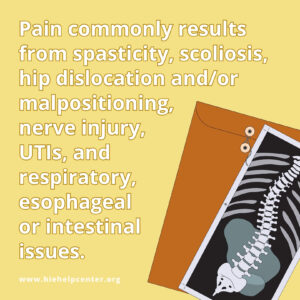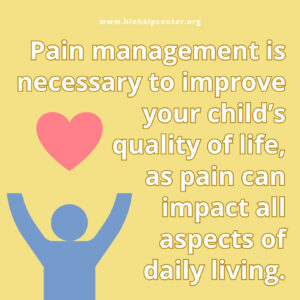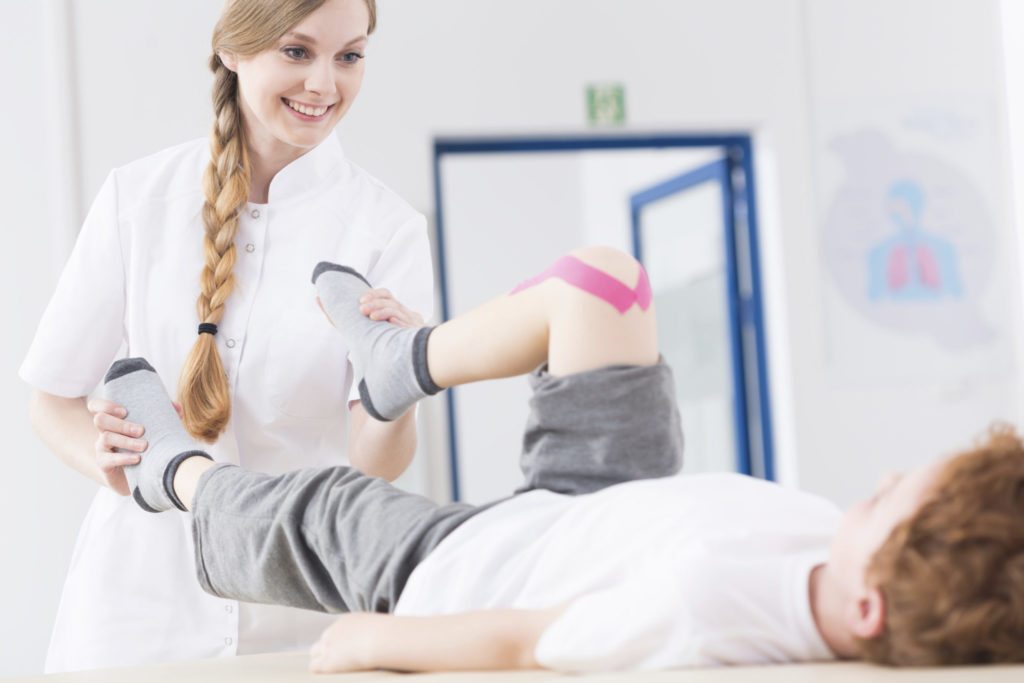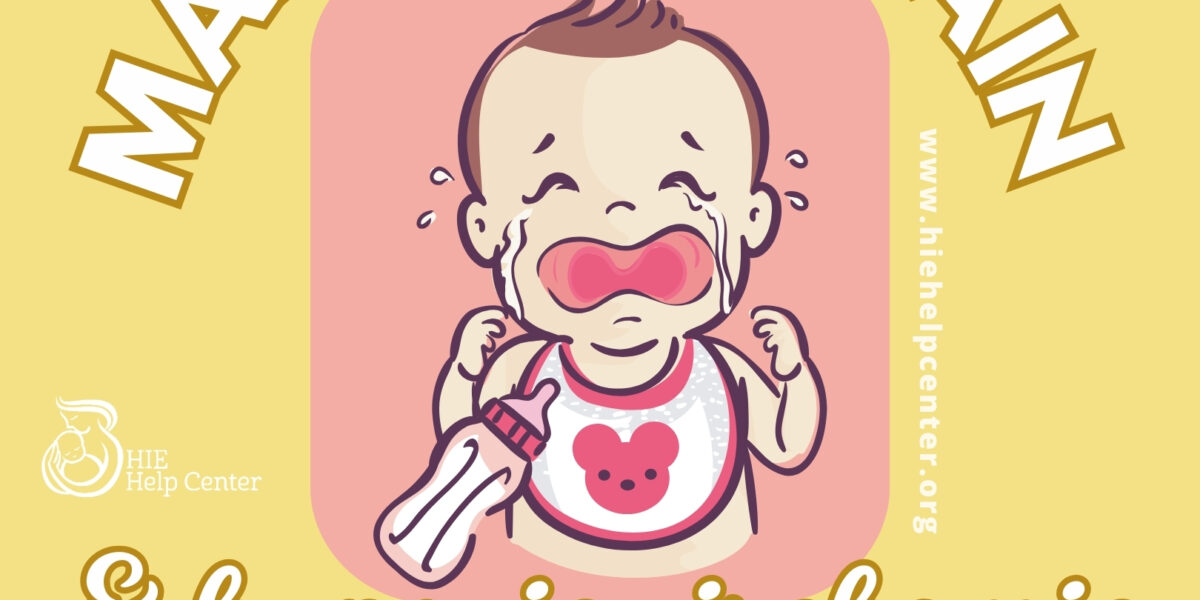Hypoxic-ischemic encephalopathy (HIE) is, at its core, a brain injury. This type of brain injury can impact a child cognitively, emotionally, intellectually, and physically. HIE can impact a child physically by damaging neural pathways, including the nerves that send signals to the muscles, in a condition called cerebral palsy. Cerebral palsy can often cause pain, muscle spasms, contractures and limited range of motion, which can make movement difficult.
What are common causes of pain?
 Children with hypoxic-ischemic encephalopathy may require certain surgical procedures; in many cases, the recovery can be very painful. In other instances, pain related to HIE can be the result of secondary conditions, such as immobility or the inability to reposition the body after a set period of time. Pain commonly results from:
Children with hypoxic-ischemic encephalopathy may require certain surgical procedures; in many cases, the recovery can be very painful. In other instances, pain related to HIE can be the result of secondary conditions, such as immobility or the inability to reposition the body after a set period of time. Pain commonly results from:
- Spasticity
- Scoliosis
- Hip dislocation or malpositioning
- Nerve injury
- UTIs &
- Respiratory, esophageal or intestinal issues
Discomfort may also stem from include nerve impingements, skin breakdowns and arthritis due to bone displacement.
How to determine when a nonverbal child is in pain?
It can be difficult to determine whether a nonverbal child is in pain, because of two main factors:
- Nonverbal children may not be able to identify or describe what they are feeling &
- Parents may have limited training in interpreting signs of pain
Individuals who can communicate should be encouraged to communicate their pain levels, but for those who cannot report at all, there are nonverbal-based behavioral pain assessment tools available to medical professionals, such as:
- American Society for Pain Management Nursing (ASPMN)’s “Pain Assessment in the Nonverbal Patient: Position Statement with Clinical Practice Recommendations”
- FLACC Assessment Tool
- CHIPPS, NIPS and CRIES Scales for Neonates
- Riley Infant Pain Scale (RIPS) for Infants
- PIPPR-R for Neonates
Pain management
 Pain management is necessary to improve the child’s quality of life, as pain can impact all aspects of a child’s daily living, including social, physical and cognitive functioning. Parents who are worried about managing their child’s pain should consult with a medical professional regarding methods of minimizing symptoms and controlling the underlying causes.
Pain management is necessary to improve the child’s quality of life, as pain can impact all aspects of a child’s daily living, including social, physical and cognitive functioning. Parents who are worried about managing their child’s pain should consult with a medical professional regarding methods of minimizing symptoms and controlling the underlying causes.
Your child’s physician may recommend strategies such as therapy, medication, and/or surgical procedures. The kind of treatment a child will receive will depend on their condition’s severity and other factors.
Getting a referral to a specialist
The child’s primary care physician will likely be the first point of contact for the family. Depending on the root cause of the pain, the physician may refer the child to a specialist, or continue treating the child themselves. They may refer you to specialists such as:
- Occupation and/or physical therapists
- Orthopedists
- Neurosurgeons
- Rheumatologists
- Neurologists
- Physiatrists
- Chiropractors &
- Massage therapists
to develop a comprehensive pain management approach. Parents may also consider taking their child to a pain management specialist or clinic.
Physical and/or occupational therapy
 In many cases, physical and/or occupational therapy can help reduce or prevent painful HIE-related physical issues before they worsen, as these therapies can increase strength, range of motion, stretching, endurance, and physical stability. All of these factors can reduce the risk of painful contractures and musculoskeletal deformities.
In many cases, physical and/or occupational therapy can help reduce or prevent painful HIE-related physical issues before they worsen, as these therapies can increase strength, range of motion, stretching, endurance, and physical stability. All of these factors can reduce the risk of painful contractures and musculoskeletal deformities.
Medications
Medications are the next line of defense against pain. Over-the-counter medications (such as Tylenol, Motrin or Advil) may be common, though physicians can sometimes provide prescription pain medications that prevent pain receptors in the brain from firing. The type of medication prescribed largely depends on the pain’s cause. Children with spasticity-related pain may be prescribed anticholinergics or antispastic medication (such as Baclofen, administered as ITB therapy), which children with severe cerebral palsy may be given opioids such as oxycodone. Children with seizures may be given anticonvulsants to reduce seizure activity and prevent pain from seizure-related injuries. Other medications for pain-related issues may include:
- Anti-inflammatories
- Stool softeners (for constipation-related gastric pain) &
- Antidepressants (to relieve emotional/psychological pain in the form of depression and/or anxiety)
All medications must be monitored by a medical professional, including over-the-counter medications, to ensure the child does not have adverse reactions or drug interactions.
Other solutions (which may be appropriate for some people but not others), include:
- Pulsed radiofrequency
- Botox injections
- Surgery (including orthopedic surgery to making walking less painful, selective dorsal rhizotomy to reduce spastic pain, and spinal surgery to provide trunk stability)
About HIE Help Center
HIE Help Center is run by ABC Law Centers, a medical malpractice firm exclusively handling cases involving HIE and other birth injuries since 1997.
If you suspect your child’s HIE may have been caused by medical negligence, contact us today to learn more about pursuing a case. We provide free legal consultations, during which we will inform you of your legal options and answer any questions you have. Moreover, you would pay nothing throughout the entire legal process unless we obtain a favorable settlement.
You are also welcome to reach out to us with inquiries that are not related to malpractice. We cannot provide individualized medical advice, but we’re happy to track down informational resources for you.

